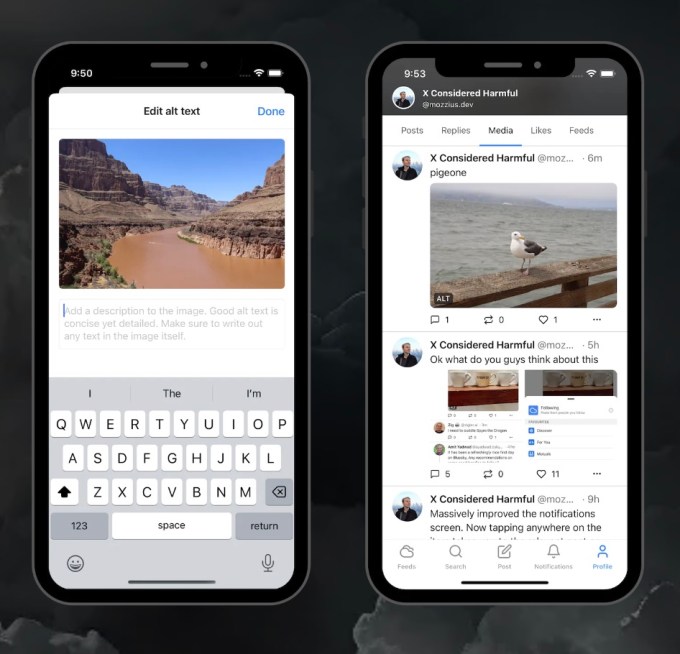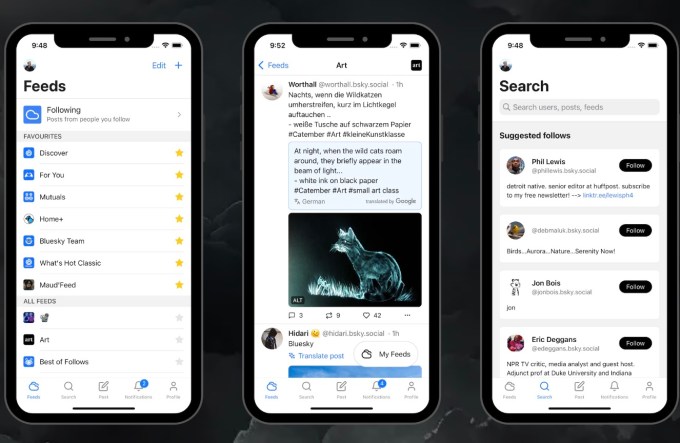Bluesky, the Jack Dorsey-backed Twitter alternative, is getting its first third-party app for mobile users: a new app called Graysky. Though numerous Bluesky projects built on the company’s API are already in the works or in testing, Graysky will be the first to ship to the App Store, where it’s now available for preorder with an October 21 launch date. It will also arrive on Android. The app promises an improved Bluesky experience with additional features like support for GIFs, inline translation, an easy way to view everyone’s likes, a feeds-first layout, hashtag support and more.
Built by London-based software engineer Samuel Newman (@mozzius.dev on Bluesky), the idea to create a Bluesky client was not initially driven by an interest in the company’s decentralized networking protocol, the AT Protocol, which will eventually allow Bluesky to operate more like Mastodon where people can set up their own servers that interconnect.
Rather, explains Newman, Bluesky was appealing because it’s simply a better Twitter.
His excitement over the new social network prompted him to start building a third-party client as a fun side project. But he then realized that Bluesky was lacking support for various features that his app could support. For example, Bluesky hadn’t yet rolled out support for viewing your own likes at the time, so that was an early focus for Graysky and one that gained it a following as users clamored for early access.
Though Bluesky has now shipped support for likes on users’ profiles, Graysky aims to stay a step ahead of the official app by supporting features that Bluesky does not. For example, Graysky lets you see everyone’s likes, not just your own — similar to Twitter/X. It will also support the ability to send GIFs powered by Tenor that are backward compatible with the official app, and supports inline translation within threads.
To differentiate itself from Bluesky beyond feature set alone, Graysky sports a unique user interface where instead of landing you on your home timeline (or skyline, in Bluesky lingo), the main tab will direct you to your set of feeds.
Image Credits: Graysky
One of the key differentiators between Bluesky and Twitter/X is its support for algorithmic choice through custom feeds. That means instead of being defaulted to an algorithmic “For You” timeline, Bluesky users can subscribe to custom feeds that the company or other developers have created that filter the posts across the network in any number of ways.
For instance, Bluesky itself offers feeds like the “What’s Hot” feed of popular posts and its earlier version, “What’s Hot Classic,” as well as feeds showing posts from your “Mutuals,” the Bluesky team and more.
Others have built custom feeds based on themes or interests, like those for cute animal pics, tech news, gardening, books, astronomy or even adult content. There are also feeds that let you filter your timeline in different ways, like seeing posts that are popular with friends or just those featuring your @mentions.
In Graysky, you start by hopping directly into the feed of your choice from its main tab. And if you’re looking for more feeds to follow, a discovery interface lets you browse all the feeds others have built.
The app also features a search interface for surfacing users, posts and feeds, unlike Bluesky’s mobile app, which only supports searching for users and posts.
Other Graysky tabs let you compose a post (where it offers a better alt text edit for attached images), access your notifications and view your profile.

Image Credits: Graysky
From the app’s main menu, you can keep tabs on your invite codes, change the app’s theme to a light or dark mode and adjust other settings like those related to your account, handle, your moderation and home feed preferences — like how much adult or violent content you’re okay with viewing or whether you want to see reposts — your muted users, and more.
Though Newman wasn’t originally inspired to build Graysky because of the AT Protocol itself, he now sees the appeal of something that’s more open-ended and more like email.
“It is really interesting,” he says. “It sidesteps a lot of the problem that Twitter is having in terms of, you know, megalomaniacs in charge, and also moderation.” Plus, he adds, the decentralization aspects would allow users to “sweep annoying users into obscurity instead of outright banning them, which I think is just a better way to run something that’s supposed to be like the public square,” Newman says.
Though Graysky’s feature set is somewhat limited at launch, the app’s planned roadmap is much more extensive.
In the future, Newman plans to add support for drafts, bookmarks, automatically generated alt text, muted words, polls, notifications, more home feed preferences, better content filters, tagging posts with language or content warnings, and lists. The latter is a much-in-demand feature for those who enjoyed being able to curate groups of people on Twitter/X, but now don’t have access to similar functionality on Bluesky.
Though Graysky was largely built by Newman, he credits others for their help with the project, including Bluesky users @alice.bsky.sh (Alice) @holden.bsky.social (Holden Foreman) and @matthewstanciu.com. Ahead of its planned October 21 launch date, Graysky was tested by more than 4,000 users.
The iOS version of the Graysky app is available now for preorder on the App Store and an Android version will also be made available.
The app will be free to use without in-app purchases for the time being, but further down the road, Newman is planning a ~£3.99 per month (just under $5 USD) subscription service for polls and a posts analytics service that shows how your posts perform over time with graphs. In the meantime, you can support development by sponsoring Newman on GitHub.










